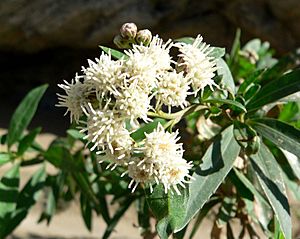Mule fat facts for kids
Quick facts for kids Mule fat |
|
|---|---|
 |
|
| Scientific classification | |
| Genus: |
Baccharis
|
| Species: |
salicifolia
|
| Synonyms | |
|
|
Baccharis salicifolia is a cool flowering shrub. It's often called mule fat. You might also hear it called seepwillow or water-wally. This plant grows naturally in the southwestern United States and northern Mexico. You can also find it in parts of South America.
Contents
What is Mule Fat?
Mule fat is a large bush. It has leaves that feel a bit sticky. This plant produces many small, fuzzy white flowers. These flowers often have a pink or red tint. Butterflies really love these flowers! The long pointed leaves might have small teeth along their edges. Each leaf also has three veins running lengthwise.
Where Does Mule Fat Grow?
This plant loves water. You will most often find mule fat growing near water sources. It is common in areas like the sage scrub community. It also grows in desert areas.
How People Use Mule Fat
People have found many uses for the mule fat plant.
Traditional Uses
The Navajo people in places like Kayenta have used this plant for a long time. They would mix it with other plants. This mixture was used as a lotion. It helped with chills that came from being in cold water.
Fire Starting
Dried mule fat wood is good for starting fires. It catches fire very easily. It has a low ignition temperature. This means it does not need much heat to start burning. People can use parts of the plant, like its stems, for fire-starting tools. These tools include spindles and hand-drill shafts.
See also
 In Spanish: Jara amarilla para niños
In Spanish: Jara amarilla para niños

